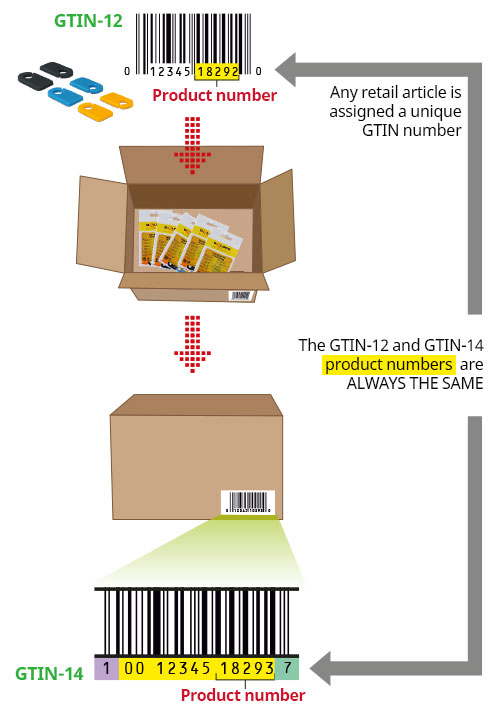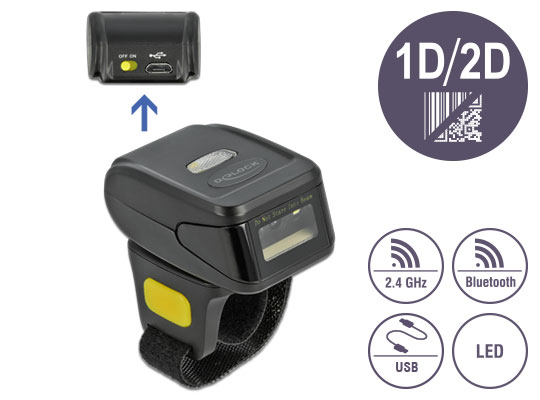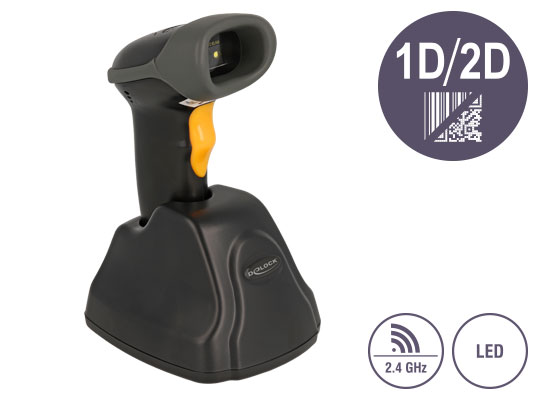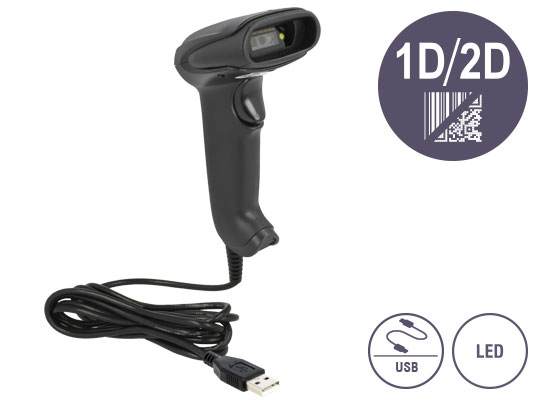Barcodes & Barcode scanner
What is it about?
Since the launch of UPC / EAN as the standard for the retail trade towards the end of the 70s, barcodes are omnipresent in everyday life. Whether on packaging, tickets or the return-shipping label by DHL, UPS, FedEx or similar logistic companies: Barcodes or also line codes are a fast, simple and accurate procedure to collect data.
Used in the right way, barcodes can reduce employee's amount of work, push the performance capability of a company, as well as record a great number of different data.

Content
What is a barcode and what does it store?
A barcode shows a series of vertically aligned bars A and spaces B of different thickness. There are various combinations of bars and spaces that represent different characters.

A barcode contains no describing data. The data are only reference numbers by which the computer looks for an appropriate data set on an electronic data medium, which contains the describing or other relevant information.
How does a barcode work?
If you go over the barcode with a barcode scanner, the light source of the scanner is absorbed by the dark bars, while it is reflected by the bright spaces in between. Inside the scanner is a photo sensor that receives the reflected light and converts it into an electrical signal.
Beneath the classic EAN codes, there are many other barcodes. Some of them are pure numeric, some have a fix length and can additionally contain numbers and letters (Code 93, Code 128 and Code 39).
Barcode examples
1D barcodes EAN / UPC for wholesale and retail trade (POS)

1D barcodes for distribution & logistic (non-POS)

2D barcodes for product information and marketing

What is UPC / EAN?
UPC, the "Universal Product Code", has 12 digits and is mainly used in the USA and Canada. EAN, the "European Article Number" is usually 13 or 8 digits and, as the name suggests, is used primarily in Europe. UPC numbers can be converted into a valid EAN number by prefixing a zero. - Various codes are discussed in more detail below.
The Code 128
Code 128 is one of the most widely used 1D barcodes due to its high information density. The entire ASCII data set can be displayed in Code 128 (letters, numbers, special characters), even upper and lower case letters are possible.
The Code 128 is popular due to its wide range of design options and can be used in most applications with relative ease. If the code has been printed correctly, it is read by all common 1D and 2D barcode scanners in the standard configuration.
Application areas of the Code 128
- Production
- Document management
- Shipping, transport & logistics
- Electronics industry
- Packaging industry
- Chemical industry
- Pharmaceutical industry
- Automotive industry
- Internal company applications (inventory, serial numbers)
The Code 39
With the Code 39 (3 out of 9), a total of 43 characters (numbers, capital letters and selected special characters) can be displayed. However, since the information density is lower than with Code 128, Code 39 is not used too often. Nevertheless, it is supported by all common 1D and 2D barcode scanners.
Character overview of Code 39


The superscript star * in Code 39 serves as a start and stop symbol. It is therefore often the first and last character in the plain text line. Code 39 has no length restriction. Furthermore, it is not necessary to pay attention to an even / odd number of digits.
Application areas of the Code 39
- Production, transport & logistics
- Parcel services
- Electronics industry
- Automotive industry
- Internal company purposes (e.g. serial and batch numbers)
- Chemical industry
- Pharmaceutical industry
- Health and medical sector
- ODETTE (= Transport Label Standard / Automotive industry & suppliers)
The Datamatrix Code
The Datamatrix Code is one of the most popular 2D codes besides the QR Code. Whereas the conventional 1D barcode is represented by different bars, the Datamatrix code is represented by the arrangement of dots of the same size (black or white boxes) within the border.
Even if the code is damaged by up to 25%, it remains legible thanks to the latest and currently most reliable version of error correction (ECC 200, Reed-Solomon error correction).
For 2D codes (e.g. Datamatrix, QR Code) 2D barcode scanners are required for reading, which have a different optical module compared to 1D barcode scanners. 2D barcode scanners can usually also read 1D codes. Datamatrix codes can usually also be read by smartphones with a camera.
Application areas of the Datamatrix Code
- Production
- Pharmaceutical industry
- Automotive industry
- Internal company applications (batch and serial numbers)
The QR Code
The QR Code (Quick Response Code) is the most modern 2D barcode. It consists of a square matrix of white and black squares. Originally developed in Japan, it was intended for marking assemblies and components for logistics in automobile production.
Besides the margin of error of up to 30%, the QR Code is very space-saving and has a flexible character set. These characteristics are also used when creating so-called design codes, where e.g. a logo was used. This is why the QR Code is often used in marketing and advertising, in addition to its original application in production logistics.
Application areas of the QR Code
- Production (serial numbers, batch numbers)
- Retail trade (web links, telephone numbers)
- Marketing (addresses, web links)
- Information (web links, information, addresses)
The EAN / GTIN Codes
The probably best-known barcode is the EAN Code (European Article Number) mentioned at the beginning. In 2009, the term EAN was replaced by "GTIN". GTIN stands for Global Trade Item Number and has been the common term since then. The main use of GTIN codes is in wholesale and retail. It identifies products in such a way that they can be registered at scanner cash registers. To be more precise: the code is the identification of the individual item itself (e.g. cable marker clip set 6 pieces) or also the carton or pallet (e.g. 12 x cable marker clip set 6 pieces). This information is stored in the code.


The standard version of the code has 13 digits, for particularly small-format products there is a short version with 8 digits, the EAN 8. As the number supply for the EAN 8 is limited, the need for this code variant must be proven separately. The last digit is the check digit.
Since the scanning process at the checkout should be as effective as possible, large supermarket chains are interested in a good print quality of the EAN code, which is why the error rate here is very low. EAN / GTIN codes are used in wholesale and retail.
Product examples Barcode Scanner by Delock

Wearable Barcode Scanner 1D and 2D with 2.4 GHz or Bluetooth - for glove 90606 and 90609
Connector 1 x USB Type-C™ female
Trigger: scan button
Internal memory: 16 MB
Weight: ca. 40 g
Dimensions (LxWxH): ca. 56 x 42 x 20 mm
Notice: Can also be used without a glove

This with a glove wearable scanner can be wirelessly connected to a PC / laptop or directly with a mobile phone or tablet. Scanned barcodes are transfered via Bluetooth, or the 2.4 GHz frequency band using the included USB dongle. Alternatively, the scanner can be connected with the computer with the 1 m long USB cable.
The scanner automatically adjusts to ambient brightness and captures up to 100 scans per second under optimal lighting conditions. Thanks to the snap-on mechanism, it can conveniently attached to the glove. So the wearer's hands are free to hold a box, for example. A matching glove for right-handers: Item 90606 and for left-handers: Item 90609.

Industrial Barcode Scanner 1D and 2D for 2.4 GHz or Bluetooth with inductive charging station
Connector charging station: 1 x USB 2.0 Type-A male
Cable length charging station: ca. 1.25 m
Trigger scanner: scan button
Reading distance: ca. 30 mm to 500 mm
Weight scanner: ca. 321 g
Dimensions scanner (LxWxH): ca. 185 x 100 x 80 mm

This scanner can be wirelessly connected to a PC / notebook or directly with a tablet / mobile phone. Data transfer is via Bluetooth or the 2.4 GHz frequency band. The charging station serves, in addition to charging the scanner, as a Bluetooth / 2.4 GHz interface and is connected to the system via USB.
The scanner automatically adjusts to ambient brightness and captures up to 120 scans per second under optimal lighting conditions. Thanks to its robust workmanship, the scanner can easily withstand falls of up to 1.80 m, making it ideal for use in industrial environments.

USB Barcode Scanner 1D and 2D • wired for stationary installation - German Version
Connector: 1 x RJ50 jack
Trigger: presentation mode
Reading distance: ca. 50 mm to 250 mm
Weight: ca. 173 g
Cable length without connectors: ca. 1.5 m
Dimensions (LxWxH): ca. 78 x 67 x 52 mm

This stationary barcode scanner is ideal for save-spacing installation in a table top and connection to the system. It is also optimal for use in access control, for example in a digitalised turnstile.
All common 1D and 2D barcode types can also be precisely captured from the smartphone. The scanner automatically adapts to the ambient brightness and captures up to 60 scans per second under uptimal lighting conditions.

Industrial Barcode Scanner 1D and 2D for 2.4 GHz, Bluetooth or USB
1 x USB Type-C™ female
Trigger: scan button
Reading distance: ca. 30 mm to 500 mm
Weight: ca. 321 g
Dimensions (LxWxH): ca. 185 x 100 x 80 mm

The scanner precisely records all common 1D and 2D barcode types, even when displayed on monitors or displays. It can be wirelessly connected to a PC, notebook, tablet or smartphone. The data transfer takes place via Bluetooth, USB cable or the included 2.4 GHz USB dongle.
The scanner automatically adapts to the ambient brightness and records up to 120 scans per second under optimal lighting conditions. Thanks to its robust design, the scanner can easily absorb falls of up to 1.80 m and is therefore ideally suited for use in industrial environments.

Ring Barcode Scanner 1D and 2D with 2,4 GHz or Bluetooth - Wireless Charging Function
1 x USB Type-C™ female
Trigger: Scan button
Internal memory: 16 MB
Weight: ca. 40 g
Dimensions (LxWxH): ca. 53 x 37 x 24 mm

The small scanner can be wirelessly connected to a PC, notebook, tablet or smartphone. Scanned data are transfered via Bluetooth, USB cable or the included 2.4 GHz USB Dongle. It precisely records all common 1D and 2D barcode types, also on monitors or displays.
The scanner can be fixed at the finger with the hook-and-loop fastener. It is suitable for right- and left-handers. The scanner can be charged via the USB-C™ female or inductive charging function in the scanner itself, for example with the charging station Item 90608.

Ring Barcode Scanner 1D and 2D with 2.4 GHz or Bluetooth - 2 pieces + Charging Station
Two scanners: see above, like Item 90607
Charging station:
1 x USB Type-C™ female
Charging power: max. 5 W
2 x LED for power
Anti-slip base
Weight: ca. 140 g
Dimensions (LxWxH): ca. 115 x 68 x 22 mm

The set consists of two Ring barcode scanners and one charging station. Scanned data can be transfered via Bluetooth, USB cable or included 2.4 GHz USB dongle. The scanners adjust automatically to the ambient brightness and capture up to 100 scans per second, under optimal lightning conditions.
The scanners can be fixed on the finger mit the hook-and-loop fastener and are suitable for right- and left-handers. They can be charged via the USB-C™ socket, inductive charging function in the scanner itself, in the supplied charging station or, for example, with the charging station Item 90608.

Ring Barcode Scanner 1D and 2D with 2.4 GHz or Bluetooth + USB
1 x USB Type Micro-B female
Trigger: scan button
Internal memory: 16 MB
Weight: ca. 39 g
Dimensions (LxWxH): ca. ca. 35 x 5 x 5 mm

This small ring scanner can be wirelessly connected to a PC, notebook, tablet or smartphone. The data transfer takes place via Bluetooth, USB cable or the included 2.4 GHz USB dongle. It precisely records all common 1D and 2D barcode types, even when displayed on monitors or displays.
The scanner automatically adapts to the ambient brightness and records up to 100 scans per second under optimal lighting conditions. It can be attached to the finger like a ring with the hook-and-loop fastener. The rotation possibility allows it to be rotated, making it suitable for both left and right-handed people.

2.4 GHz Barcode Scanner 1D and 2D with charging station
Connector: 1 x USB 2.0 Type-B female
Trigger: scan button
Reading distance: ca. 40 mm to 250 mm
Weight
Barcode scanner: ca. 146 g
Charging cradle: ca. 118 g
Dimensions (LxWxH)
Barcode scanner: ca. 16.5 x 8.2 x 6.5 cm
Charging cradle: ca. 12.0 x 9.5 x 8.0 cm

This wireless scanner can be connected to a PC or notebook. It accurately captures all common 1D and 2D barcode types at long range, as well as codes displayed on displays and monitors. The scanner automatically adjusts to ambient brightness. Under optimal lighting conditions, up to 200 scans per second are possible. It has an additional white LED that illuminates the barcode in low ambient light conditions.
The wireless range is up to 60 m indoors and up to 100 m outdoors. Data transmission of the scanned codes takes place via the 2.4 GHz frequency band. The charging cradle also serves as a 2.4 GHz interface and is connected to the system via a USB cable. The charging cradle can also be connected to a smartphone or tablet via an optional adapter cable.

USB Barcode Scanner 1D and 2D with cable • German Version
Connector scanner: 1 x RJ50 jack
Cable USB Type-A to RJ50, length ca. 1.5 m
Trigger: scan button
Reading distance: ca. 30 mm to 350 mm
Weight: ca. 150 g
Dimensions (LxWxH): ca. 160 x 90 x 65 mm
Exclusively for the output of the German keyboard
The scanner can be connected to a PC or notebook via USB. With an alternatively connected adapter, it can also be used on a cell phone or tablet. It captures all common 1D and 2D barcode types precisely at long range, as well as codes displayed on displays and monitors, up to 30 scans per second.
The scanner automatically adjusts to the ambient brightness. The USB cable is connected to the scanner via RJ50 connector and can only be removed with the included ejection tool. This way, there is always a firm, secure connection between the scanner and the system.

USB Barcode scanner 1D with cable • Line scanner
Connector: 1 x USB Type-A male
Trigger: scan button
Reading distance: ca. 25 mm to 507 mm
Weight: ca. 170 g
Cable length: ca. 2 m
Dimensions (LxWxH): ca. 156 x 71 x 91 mm

This scanner can be connected to a PC or notebook with a free USB type A socket. With laser class 1 and linear CMOS image sensor it precisely captures all common 1D barcode types at long range as well as codes displayed on displays and monitors. The scanner automatically adjusts to the ambient brightness.
Under optimum lighting conditions, up to 280 scans per second are possible. It has an additional white LED that illuminates the barcode in low ambient light. Thanks to the technology used, the laser light is harmless to the human eye.
